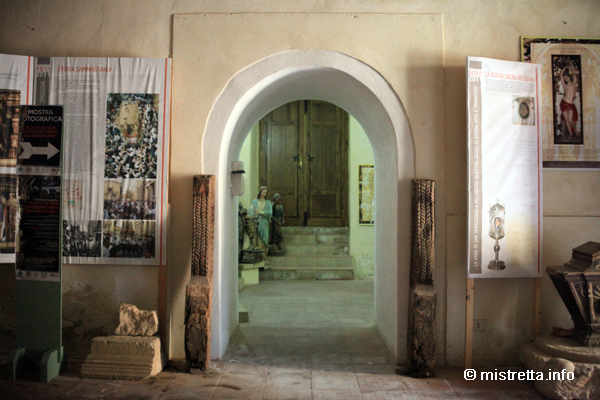
Museo Parrocchiale
E’ stato istituito nel 2000 nei cinque locali seminterrati della Matrice che si aprono sotto il transetto verso la Via Numea. In questi ambienti, destinati in passato a magazzini, è stato attuato un accurato restauro (arch. A. Lo Castro – ing. M Faillaci, 1999) che, oltre a mettere in collegamento gli originari monolocali, ha riportato alla luce elementi fondamentali per la storia dell’edificio: una parte della facciata medievale con frammenti del portale gotico dal quale si accedeva alla chiesa prima che fosse invertito il suo orientamento; il cantonale sud-occidentale della fabbrica quattrocentesca; le scalinate d’accesso a questi seminterrati, che tra il XVII e il XVIII sec. fungevano anche da cripta. Questi elementi si integrano al percorso espositivo del museo che spesso si presta ad allestimenti temporanei e tematici.
Tra i molti reperti provenienti da chiese diroccate, ricordiamo l’esile statua di S. Paolino eremita (1605), quella di S. Nicola in trono (XVI sec.), gli arredi del santuario della Madonna della Luce (al momento inagibile). Molti sono gli elementi appartenuti alla matrice medievale (basi, mensole, cornici, fastigi, ecc.), tra i quali spicca il frammento dell’affresco di una colonna dell’antico impianto basilicale datato 1488. (A. Pettineo)

Parish Museum
It was established in 2000 in the five basement rooms of the Mother Church that open under the transept towards via Numea. These spaces, once used as warehouses, have been carefully restored in 1999 (arch. A. Lo Castro, eng. M. Faillaci). The restoration connected the original premises and brought to light fundamental elements for the building history: a part of the medieval façade with fragments of the Gothic portal which gave access to the church before it was reversed its orientation; the southwestern angle of the fifteenth-century building; the entrance staircase to these basements that served as crypt between the XVII and XVIII centuries. These elements are integrated into the museum itinerary that often is used for temporary and thematic exhibitions.
Among the many finds coming from ruined churches, we remember the slender statue of St. Paul the Hermit (1605), that of St. Nicholas on the Throne (XVI century), the furnishings of the shrine of Madonna della Luce (currently unusable). There are also many elements attributable to the medieval church (bases, brackets, cornices, gables, etc.), among which stands out the fresco fragment of a column of the ancient basilica dated 1488.
